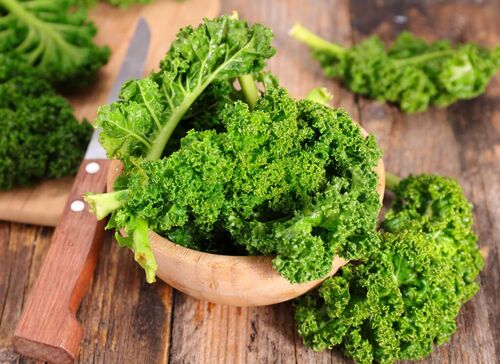Growing Kale

During the Middle Ages kale was the go-to green leafy vegetable. It was easy to grow, fairly frost resistant and a healthy addition to any mealy gruel. At the end of the Middle Ages kale mutated to develop a "head" and so cabbages were born. It is a cruciferous vegetable like cabbage, broccoli, cauliflower, collard greens and Brussels sprouts.
When Sowing Kale
Start kale indoors 10 to 6 weeks before the last spring frost and plant them out 5 to 6 weeks later. You can also sow them directly in the garden from early spring to early summer, 15-20cm apart, 5mm (¼”) deep in moist but firm soil, ideally enriched with compost a few months before.
Sunny spot for Kale?
Kale grows best in full sun to partial shade. Plan to provide your kale plants at least 6 to 7 hours of direct sun per day. Space kale 18 to 24 inches apart in an area with well-drained, fertile soil with a pH of 6.5 to 6.8.
When Watering Kale
Kale needs plentiful, consistent moisture – one to two inches of water per week is usually about right. Make sure you have a thick layer of mulch around your plants to help with moisture retention.
Protecting kale
-birds : Protect the plants from birds by covering them with netting or fleece. Scarecrows and bird-scaring mechanisms work for a while, but the most reliable method of protection is to cover plants with horticultural fleece or mesh.
-whiteflies : Whiteflies are easy to miss because they are so tiny! Fortunately, whiteflies need to reach high population levels to cause serious damage to their host plants. If you have a small population of whiteflies in your garden, often beneficial insects like predators and parasitoids will help you control your whitefly population.
-slugs & snails : The most effective and low impact way to control slugs and snails is by hand picking. Slugs commonly hide down in crevices in the soil and you can often dig down around a damaged plant to find the culprit. Ducks love slugs and snails and are one of the best controls. Chickens like them as well, but do more damage to crops. Toads, snakes, birds and Ground Beetles (probably the most important) all kill slugs and snails. The natural salts that form from oxidizing copper also act as a repellent. Uncoated copper flashing, banding, and mesh are all suitable options to lay around any area in need of protection.
Different types of kale
The most common variety is deep green, but other kales are yellow-green, white, red, or purple, with either flat or ruffled leaves and there's fall kale and winter kale.
Kale seeds in our shop
In our webshop we have 5 types of kale (including 2 organic kale types:
- Organic Kale Seeds Purple (Roter Grunkohl)
- Organic kale seeds Westlandse
- Kale Seeds Reflex F1 Hybrid
- Kale Seeds Scarlet Purple
- Kale seeds Westland Autumn (late)
Harvesting Kale
You’ll know when it’s ready when it’s about 12 inches / 30 cm. tall and the leaves are the size of your hand or bigger. Leaves that are the size of your palm are younger and more tender whereas the bigger leaves will be older and a bit tougher. Rest assured, both are delicious! It’s also important that you harvest kale from the bottom up. Pruning the top leaves can accidentally stunt the growth of your kale plant. Feel free to cut off any yellowing leaves as well to help your plant really focus it’s energy on growing the other healthy leaves.
When is kale ready to pick?
Kale is ready to pick approximately 60 days after seeds have been planted. At this point, healthy plants will have upwards of ten leaves, with small ones in the center and larger ones on the outside. If you're looking to grow baby kale, plants will be ready to pick and enjoy in 25 to 30 days after they are sown.
Is kale typically Dutch?
Kale is not typically Dutch because it’s also eaten in Scandinavia, Germany, Belgium, England and Ireland. For most of the twentieth century, kale was primarily used in the United States for decorative purposes; it became more popular as an edible vegetable in the 1990s due to its nutritional value.



